Rick Johnson is executive director of the Idaho Conservation League. After working for ICL in the mid-1980s, he spent eight years in Seattle, working with the Sierra Club to protect the Northwest’s ancient forests, often as a “frequent-flyer lobbyist” in Washington, D.C. He returned to Idaho in 1995.

Monday, 27 Jan 2003
BOISE, Idaho
On this rainy morning in Boise, after reading a newspaper op-ed from a motorized-recreation activist criticizing the wilderness advocacy of the Idaho Conservation League, I’m reminded that I owe the work I do to the White Clouds. The White Clouds are a spectacular mountain range in central Idaho; together with the Boulders, they form the largest unprotected chunk of pristine National Forest left in the lower 48 states.
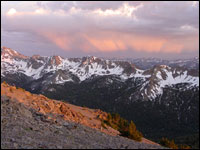
The White Clouds.
Photo: Lee Melly.
Twenty years ago, I was an idealistic volunteer for ICL, trying to get Congress to designate the White Clouds as a wilderness area. Despite a few legislative near misses, the White Clouds remain unprotected. Still, they are a touchstone for my life in conservation. In this line of work, lessons come daily and often come hard, but I’ve been able to maintain my original idealism, in part because the White Clouds continue to inspire me.
The Idaho Conservation League turns 30 this year — 30 years of working to protect and restore the water, wildlands, and wildlife of Idaho through citizen action, public education, and professional advocacy. Over those three decades, we’ve grown from a few loose threads across Idaho to three offices, 14 staff, and a cadre of extraordinary volunteers; these threads are now deeply woven into the fabric of Idaho.
I just finished talking to Amy Haak, who’s preparing a conservation-biology assessment of the state to help guide our work. The assessment will document the science but cannot capture the magic of what lies outside. On this winter Idaho day, wolves roam the Salmon-Selway country, the largest wildland ecosystem in the lower 48 states. Herds of elk paw through the winter crust for food and shake off the falling snow. Higher up, lynx prowl for snowshoe hare, and the rugged peaks are finally getting the snow we’ll all need as run-off come summer.

Grey days for grey wolves?
Photo: USFWS.
In the lower valleys of the Salmon watershed, wild salmon and cutthroat trout hug the cobbles of waters swelling with the weekend’s rain. In the rich forests of the Clearwater, Idaho today remains as Lewis and Clark saw it two centuries ago. Yet change is afoot. We are one of the nation’s fastest growing states; many more people want to use and enjoy what was once treasured by just a few. And from the nation’s capital, an avalanche of environmental rollbacks threaten to bury real places and values under policies we will long struggle to dig out of.
Jerry Pavia, our past board president, just called about an upcoming science gathering on grizzlies in the Idaho Selkirks. Jerry’s been at this work for decades, and he reminds me of Brock Evans, a pioneering conservationist who once worked on Idaho issues and is now battling cancer. “Endless pressure, endlessly applied,” Brock says. “That’s how we win.” Some days, running a nonprofit feels like the carnival clown spinning plates on fingers and feet; on those days my work is reduced to endless meetings, endlessly attended. I don’t know if we can help Jerry get the dough he needs for the science meeting, but Brock is right, and Jerry personifies it. Stay focused. Do good work. Keep doing good work. A mantra for a Monday morning.
Idaho is tough turf for conservationists. We’ve been vilified by a few officeholders who resent a vision of Idaho as something other than a colony for extractive industries and polluters. Special interests have accused us of “rural cleansing,” a particularly reprehensible bit of word craft. A couple years back, after timber giant Boise Cascade announced the closure of a log mill, 150 angry mill workers filled our office parking lot and police were called in.
But we are breaking through. Victories do come, and losses are contained. We succeed because so many love Idaho’s outdoors. We practice conservation by complementing Idaho’s conservative values rather than trying to overthrow them. We succeed because we’ve defended Idaho’s core values while respecting those who disagree with us, challenging as that can be. We build bridges where we can and provide strong advocacy where we must.
The coming week is going to be crazy. Fundraising challenges abound, the legislature is in session two blocks away, and we’re in the midst of annual planning for our staff. I’ve got to give a speech to the Boise Rotary and attend a planning meeting with our lawyers. My board president will be here at 1:30 and at 3:00 I’m being interviewed about fundraising in a shrinking economy.
Looking out the window, the rain-covered statehouse dome draws my eyes, but the memory of the snow-covered White Clouds lifts my spirit. These soaring peaks continue to inspire. Several days ago, Rep. Mike Simpson, a conservative Idaho Republican, expressed his intention to introduce a wilderness bill for the White Clouds, Boulders, and Pioneers by mid-year. “Endless pressure, endlessly applied.” It works. My phone is ringing; emails are waiting. Monday begins.
Tuesday, 28 Jan 2003
BOISE, Idaho
Would you invite an environmentalist over for dinner? Recent focus groups designed to explore public perceptions of environmentalists suggest that many folks would not. Why? They think we’re picky, that we complain too much, and that we won’t eat the food.
I think I’m fun to have over for dinner. You probably are, too. The problem is perception. In politics, however, perception is as important as reality, and a lot of our work gets done in the political arena — so both the message and the messenger matter.
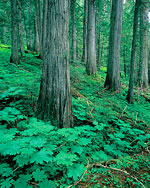
Lush green devil’s club covers the ground beneath old-growth cedars in a northern Idaho roadless area.
Photo: Jay Krajic.
Today I’m the featured speaker at the Boise Rotary Club. I’m going there to talk about the Idaho Conservation League and our work to protect the Boulder, White Cloud, and Pioneer Mountains. When I talk, I don’t want to offend the group or make anyone angry. I certainly don’t want anyone to be bored. I want my audience to care about Wild Idaho, and understand why the work I do is important to them. Then I want them to help me protect this great place. I need to meet my audience where they are, and speak to the values they hold close to the heart.
Idaho is an easy place to love; just go outside. But it is a hard place to protect, in part because of its long history of resource extraction, and in part because of a challenging cast of characters in public office. Another factor is the success of a few special interests groups in leveraging public opinion, often using what should be our imagery. But a more controllable factor is that people like me sometimes say dumb things. So today, when I’m talking to the good folks of the Rotary Club, I’ll try not to put my foot in my mouth by sounding shrill, unbelievable, or out of step with my neighbors. I learned this lesson the hard way: When talking to reporters, I know I’ve given a few sound bites that were real zingers — fun to say, but counterproductive to the cause. One lousy quote can harm my own efforts more effectively than my opponents can.
Faith Bremner and I just talked for 45 minutes about the current national political climate. She’s the Washington, D.C.-based reporter for Gannett News Service, the parent company of the Idaho Statesman. When my comments get chopped up and placed in a story (assuming they get used at all), will what I say build empathy with the reading public? Will I be a trustworthy and credible spokesperson? Or will I sound like a nut? The whole time I was talking to Faith about the environmental rollbacks that are sure to come, I kept thinking, “How will this play with the busy mom reading this before the kids head out to school?” I want to sound like someone she’d like her kids to meet. That’s who I am, after all.

Rafters enjoy whitewater rapids beneath spectacular basalt cliffs in the Owyhee Canyonlands of southern Idaho.
Photo: Steve Bly.
Not all my work on this sunny Tuesday is about being liked and listened to. Our conservation advocacy staff meets with our legal team this afternoon for planning. Bad things are happening to Idaho’s forests, streams, air and wildlife, and sometimes it takes a lawyer to solve the problem. Our legal work with Laird Lucas and the rest of the Boise-based Advocates for the West is a vital part of our program. Litigation not only stops environmentally harmful projects; sometimes, it is also a catalyst for negotiation and creative problem-solving.
Sometimes, we also need litigation to defend laws the government has decided it would rather ignore, like the Clinton-era “roadless rule,” which protects millions of acres of national forest. When the state of Idaho challenged the rule, Bush’s lawyers took a pass — but we intervened and ultimately won an extraordinary victory thanks to Doug Honnold of Earthjustice.
Our work to protect Idaho’s values and Idaho’s wilderness requires a multitude of strategies. We can win in the courts, but we must also win in the court of public opinion. A few years back, a staffer for the then-speaker of the U.S. House of Representatives told me (apropos of an environmental issue we were discussing), “That’s nice, and you might even be right, but no one in my district believes you.”
I heard that message. I learned something, too. Let’s hope I can take that lesson and put it to work during my speech to the Rotary Club.
Wednesday, 29 Jan 2003
BOISE, Idaho
Bert Bowler came by today. A recently retired fisheries biologist and active salmon advocate with Idaho Rivers United, Bert is the son of Bruce Bowler, an attorney who helped pioneer environmental law in Idaho.
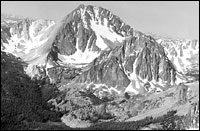
Ernie Day’s classic photo of Castle Peak in the White Clouds, almost the site of an open-pit mine.
When Bruce died last year, we lost one of Idaho’s great conservationists, a big man with a soft voice who blocked dams on Hells Canyon, helped protect the Sawtooth National Recreation Area and the Middle Fork Salmon River, and, with Cecil Andrus and a host of others, successfully kept a giant open-pit molybdenum mine from being built in the White Cloud Mountains.
Another key player in those days was Ernie Day. Ernie (who had a less quiet voice) was an advocate for the White Clouds when they needed it most, and his photographs of the high peaks are Idaho classics. Ernie brought the wonder of Castle Peak — the site of the proposed mine — to thousands who hadn’t yet seen it.

Idaho Statehouse, two blocks from our office.
Bert came by my office today to give us a huge print of one of Ernie’s photos of Castle Peak. This photo hung in Bert’s father’s law office for decades. “Your office is where this photograph belongs now,” Bert said.
A few years ago, when the Idaho Conservation League moved into a historic home two blocks from the Statehouse, we didn’t realize we’d also created a home for some Idaho conservation history. Not long after we moved in, my former colleague at the Sierra Club, Doug Scott, gave me his signed “red-line” copy of the River of No Return Wilderness bill to put in the office. “That’s where this should live,” he told me — just like Bert said today. While the immediacy of each day’s work keeps our attention focused on the present, every step we take is the continuation of a path broken by others who came before us. It is on that path, following those pioneers, that we walk toward the future.
I think I surprised a couple of folks at the post office today when I pulled out my camera and took a picture of our P.O. box. I certainly got some serious scrutiny from the security guy. But there it is: P.O. Box 844. It looks no different than the hundreds of others, but for 30 years, it’s been ours. Agencies, policymakers, media, and vendors all endeavor to stuff it, but the mail that matters most are the envelopes from our members and supporters. And today the box was stuffed; kind of gave me a warm feeling.
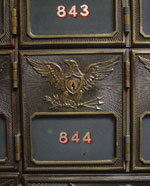
The portal.
That P.O. box is also the portal through which our money comes. We raise some funds through personal visits with donors, and occasionally someone stops by the office to renew a membership and stay in touch. The Internet is also becoming more important to us, and monthly giving is a growing part of our program. But the P.O. box is where most of the dollars come in, and today, for my very first time, I got the key from Andrea and walked the few blocks downtown to pick up the mail. There were a bunch of tear-off cards from our recent Owyhee alert, the ubiquitous bills and solicitations, but also a handful of donation envelopes.
All across the country, nonprofits are scrambling for money. The stock market has been down for three years running, which has hurt many charitable foundations that support us. In the Pacific Northwest, it is estimated there will be $8 million fewer foundation dollars available for environmental nonprofits. Government funding has been slashed nationwide, and while ICL doesn’t depend on such revenue, those that do (or used to) are now competing for limited donor dollars with us. Increased unemployment and general economic skittishness affects our members; together, these factors create the so-called “perfect storm.”
Meanwhile, the New York Times has called the alignment of the current Congress, the Bush administration, and the nation’s courts the “perfect storm” for environmental rollbacks. Together, the poor funding outlook and the even bleaker political situation makes for a tough combination, one that is testing even the best nonprofit public interest groups. Concern about it dominates my working life, and occasionally fills those sleepless moments around 3:00 a.m. Every executive director reading this knows exactly what I mean.
Luckily, we have an incredibly active and dedicated following. Our members love Idaho, and they rely on us to protect it, just as we rely on them to support our work. It is a gratifying and important relationship.
This morning, I attending a fundraising breakfast for one of our ally groups; this is an important time for us all to come together, to do good work, and support each other. It won’t get easier anytime soon.
Thursday, 30 Jan 2003
BOISE, Idaho
Leaving the office last night, I passed under a “Welcome Volunteers” sign; Rachel (our outreach coordinator) was in the conference room training a new cadre of conservationists. From newly recruited activists to long-time board members, volunteers fuel our engines. It’s a fuel we can never afford to waste.

Selkirk Mountains in the Idaho Panhandle by the Canadian border.
Photo: Jerry Pavia.
Other fuels can consume us. This week I was expecting to have plenty of mellow catch-up time and no travel; instead, I found myself reaching terminal velocity. The piles on my desk are growing and dirty mugs mark the busy days. I like a fast pace, but too much is too much. Time to slow down. I walked to work; even biking felt too fast today. There was snow within view in the mountains, but walking through Boise’s North End, I saw my first spring crocus blossoms. Can’t beat that.
As I approach the office, thoughts of work build like grid-locked traffic, and a yellow caution sign suddenly appears: “Board meeting in one week!” Uh oh. Board packets need to go out now. Idaho is a big state and our volunteer board comes from the Panhandle by the Canadian border on down to the Greater Yellowstone ecosystem, through Sun Valley and back into Boise. Board members take considerable time from their lives to gather and help direct our rapidly evolving organization, and I owe it to them to get them good prep materials for this meeting.
They are going to get hit with a lot in this packet. We are reviewing our program plans for 2003 and setting the stage for work on a new multi-year strategic plan. This includes all our issues and our fundraising efforts to support them, as well as outreach and training. The board is about to get our first-ever attempt to capture a detailed organizational year on paper.
At first, developing the organization plan felt like creating order out of handfuls of cooked spaghetti. We do a lot of work, and a lot of the work overlaps. We also have to react, practicing environmental triage as new issues roll in. It’s actually a lot easier just to react, and when we were smaller, that’s most of what we did. But it is through planned work that our mission substantively advanced. Thoughtfully planning engages all the gears of the machine; reacting too often just spins one. Still, this is a lot, and capturing it all on paper was daunting. But after a lot of work, I sense order from orzo.
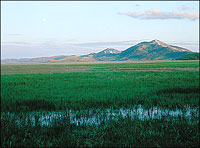
Grays Lake in eastern Idaho.
Photo: Jay Krajic
We work on everything from industrial dairy issues to timber sales to wilderness to endangered species to clean air to mining to — well, you get the picture. In a few hours, Justin (our program director) and I need to make sure the whole organization plan is readable and somehow doable given the number of staff we actually have. Right now, you’d think we have a staff of 50 based on the amount of work we’re trying to do. We don’t, and last I checked, 2003 only has 52 weeks. We’re creating new planning tools at the same time we’re creating the content; neither will be perfect by the time the board gets it, but it’s a big step forward and it will keep getting better.
Our organization has changed. We’ve grown, and in so doing, we’ve lost a bit of the family-like culture we once had. But we get a lot more done, and a lot more people are looking to us for leadership. Christine Letts with the Harvard Business School has written of high-performance nonprofits, and the Brainerd Foundation provided me an opportunity to talk with her about lessons we can — and have — learned. Training Resources for the Environmental Community has taught us a lot, and as Dyan Oldenburg says when I tell her of a challenge before me: “This is great, Rick, you have another opportunity for growth.”
And I have grown. Each day, we make some progress toward taking our work to a new level. For me, this keeps the work fresh and exciting. We’re just a small, grassroots-based conservation group in the Pacific Northwest. But we’re working real hard to be a really good one.
I’ve got a meeting this morning to go over the first draft of a science-based conservation assessment created for us by Conservation Geography to help guide our work. I’ll follow that with a call to the Campaign for America’s Wilderness. This is a new partner of ours, and it’s great to work with them. I’m both a collaborator and a board member, and I’m excited about what we are going to do together.
And I’ve got to get this hefty board packet out.
Friday, 31 Jan 2003
BOISE, Idaho
“Good advice doesn’t come in a box marked ‘good advice.'” So says David Frum, a former presidential speech-writer. As I walked through the office this morning, Frum’s words rang true. All good leaders know that one of the most important things they can do is surround themselves with talented people; that’s where your good advice will really come from.

Stupendous scenery in central Idaho.
Photo: Steve Bly.
It’s all about the team, and here at the Idaho Conservation League, we’re lucky to have a very good one. As executive director, I get credit when things are good, and can take the blame when they aren’t, but in truth everything here is always a group effort.
Take today: Justin is tracking the soaring stock price of an Idaho mining company that nonetheless says it can’t afford to stop dumping toxics into a North Idaho river. He’s outraged and calling our lawyer. Linn and Jamie just got back from Washington, D.C., where they were briefing national groups on our White Clouds wilderness work and are already planning new meetings to advance our agenda. Liz, eight months pregnant, has our membership system ticking like a watch, and has helped tremendously with our work with foundations, relieving me of a load I once carried.
John just returned — with a nasty cold — from a long meeting set up by one of our U.S. senators to discuss declining elk numbers in North Idaho; now, he’s shifted gears and is working on the Owyhee Canyonlands. Lauren came back from a tour of industrial dairies and is over at the statehouse in front of the nation’s most conservative legislature defending a local public-interest provision these animal factories want stripped from our water law. Rachel is helping ensure that our members know about this public policy rip-off, and is providing a way for them to meaningfully respond. We’ll also celebrate her engagement this weekend at Lauren’s house.

Bugling elk — part of the soundtrack to wild Idaho.
Photo: Steve Bly.
Jonathan, based in our North Idaho office, made the newspaper today because the U.S. Forest Service listened to us and will keep a timber sale out of a key roadless area. Mary Beth recently finished the design work for our quarterly newsletter and sent it to the printer, and has helped me with the photos for this column. JR has his finger on the pulse of timber sales throughout the state, and implements a broad program of agency oversight. Suki has run through the most recent budget numbers, met with our agent about insurance issues for staff, and was going to race in a major Nordic event we’re cosponsoring this weekend, until she toasted a shoulder. As deputy director, she helps keep me sane.
Vicky and Andrea are processing the bills and checks, helping prepare for our upcoming board meeting, and are our front lines on the telephone, ensuring that calls go where they should and that members and the public get the service they have come to expect from the Idaho Conservation League.
I’m honored to work with these folks. They teach me a lot.
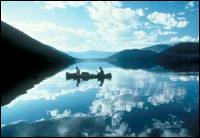
Canoe on beautiful Upper Priest Lake in northern Idaho.
Photo: Jay Krajic.
We are lucky. We work every day to protect one of America’s most blessed places. The autumn bugling of elk, the lone moonlit howl of a wolf, or the crack of crashing bighorn rams are all sounds of wild Idaho. So is the scream of the fishing reel with a wild steelhead on the line, a gasp for breath on the top of Snowyside Peak, and the cry of “yes!” after a kayaker’s first whitewater roll in the Payette. The cry of the wind, the rush of a river — this is the soundtrack for our work.
I’ve loved Idaho from the moment I first saw it, but it was in Washington, D.C., that I decided to make a life of protecting it. It was 1984, and I was a bone-tired volunteer watching the late afternoon light stream across the old Sierra Club conference room on Pennsylvania Avenue. It was a Friday, just like today, and I’d walked the halls of Congress all week talking about this wonderful place called Idaho. I guess you could call it an epiphany. It was right then, literally, that I decided I’d do whatever it took to get a job doing this. And as the philosopher Robert Hunter says, “What a long, strange, trip it’s been.” I wouldn’t trade it for anything.

